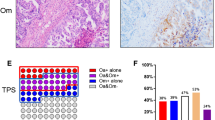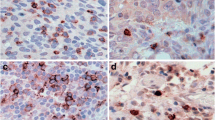Abstract
Purpose
Programmed death-ligand 1 (PD-L1) was expressed in various gynecology tumors. High-grade ovarian cancers could be a potential target for immune anti-PD-L1 modulate therapy. Antibodies targeting PD-L1 molecules are emerging cancer therapeutics. This study was designed to evaluate the expression of PD-L1 marker in the high-grade ovarian cancer types and evaluate its prognostic potential.
Methods
The study included 18 patients with ovarian high-grade serous cancer (HGSC) and 11 patients with clear cell cancer (CCC) histology type, both in the International Federation of Gynecology and Obstetrics (FIGO) stage I. The expression of the PD-L1 marker was measured by tissue microarray-based immunohistochemistry. Expression levels of PD-L1 were correlated with the presence of tumor-infiltrating lymphocyte (TIL) and other histopathology parameters.
Results
HGSC ovarian cancers predominantly had low PD-L1 expression, while CCC ovarian cancers had high PD-L1 expression (p < 0.001). PD-L1 expression did not show significant differences considering analyzed parameters other than histology type (localization, size, FIGO stage, lymphovascular invasion, tumor necrosis, and presence of TIL) among all ovarian cancers. There was no statistically significant difference in any of the tumor characteristics within histologic types of ovarian cancers.
Conclusion
PD-L1 expression was significantly higher in clear cell histology type than in high-grade serous ovarian cancers in FIGO I stage.





Similar content being viewed by others
References
Siegel RL, Miller KD, Jemal A. Cancer statistics, 2020. CA Cancer J Clin. 2020;70(1):7–30. https://doi.org/10.3322/caac.21590.
van Zyl B, Tang D, Bowden NA. Biomarkers of platinum resistance in ovarian cancer: what can we use to improve treatment. Endocr Relat Cancer. 2018;25(5):R303–18. https://doi.org/10.1530/ERC-17-0336.
Howitt BE, Strickland KC, Sholl LM, Rodig S, Ritterhouse LL, Chowdhury D, et al. Clear cell ovarian cancers with microsatellite instability: a unique subset of ovarian cancers with increased tumor-infiltrating lymphocytes and PD-1/PD-L1 expression. Oncoimmunology. 2017;6(2):e1277308. https://doi.org/10.1080/2162402X.2016.1277308.
Jacobs IJ, Menon U, Ryan A, Gentry-Maharaj A, Burnell M, Kalsi JK, et al. Ovarian cancer screening and mortality in the UK collaborative trial of ovarian cancer screening (UKCTOCS): a randomised controlled trial. Lancet. 2016;387(10022):945–56. https://doi.org/10.1016/S0140-6736(15)01224-6.
Piao J, Lim HJ, Lee M. Prognostic value of programmed cell death ligand-1 expression in ovarian cancer: an updated meta-analysis. Obstet Gynecol Sci. 2020;63(3):346–56. https://doi.org/10.5468/ogs.2020.63.3.346.
Pietzner K, Nasser S, Alavi S, Darb-Esfahani S, Passler M, Muallem MZ, et al. Checkpoint-inhibition in ovarian cancer: rising star or just a dream? J Gynecol Oncol. 2018;29(6):e93. https://doi.org/10.3802/jgo.2018.29.e93.
Robainas M, Otano R, Bueno S, Ait-Oudhia S. Understanding the role of PD-L1/PD1 pathway blockade and autophagy in cancer therapy. Onco Targets Ther. 2017;10:1803–7. https://doi.org/10.2147/OTT.S132508.
Pawłowska A, Kwiatkowska A, Suszczyk D, Chudzik A, Tarkowski R, Barczyński B, et al. Clinical and prognostic value of antigen-presenting cells with PD-L1/PD-L2 expression in ovarian cancer patients. Int J Mol Sc. 2021;22:11563. https://doi.org/10.3390/ijms222111563.
Battaglia A, Piermattei A, Buzzonetti A, Pasciuto T, Zampetti N, Fossati M, et al. PD-L1 expression on circulating tumour-derived microvesicles as a complementary tool for stratification of high-grade serous ovarian cancer patients. Cancers. 2021;13:5200. https://doi.org/10.3390/cancers13205200.
Bansal A, Srinivasan R, Rohilla M, Rai B, Rajwanshi A, Suri V, et al. Immunoty** in tubo-ovarian high-grade serous carcinoma by PD-L1 and CD8+ T-lymphocytes predicts disease-free survival. APMIS. 2021;129(5):254–64. https://doi.org/10.1111/apm.13116.
Clark CA, Gupta HB, Sareddy G, Pandeswara S, Lao S, Yuan B, et al. Tumor-intrinsic PD-L1 signals regulate cell growth, pathogenesis, and autophagy in ovarian cancer and melanoma. Cancer Res. 2016;76(23):6964–74. https://doi.org/10.1158/0008-5472.CAN-16-0258.
Choi CH, Kim KH, Song JY, Choi SJ, Kim L, Park IS, et al. Construction of high-density tissue microarrays at low cost by using self-made manual microarray kits and recipient paraffin blocks. Korean J Pathol. 2012;46(6):562–8. https://doi.org/10.4132/KoreanJPathol.2012.46.6.562.
Oh SY, Roh CR. Autophagy in the placenta. Obstet Gynecol Sci. 2017;60(3):241–59. https://doi.org/10.5468/ogs.2017.60.3.241.
Jovanović L, Janković R, Ćirković A, Jović M, Janjić T, Djuričić S, et al. PD-L1 expression in different segments and histological types of ovarian cancer according to lymphocytic infiltrate. Medicina (Kaunas). 2021;57(12):1309. https://doi.org/10.3390/medicina57121309.
Dako. PD-L1 IHC 22C3 pharmDx interpretation manual – gastric or gastroesophageal junction adenocarcinoma. PD-L1 IHC 22C3 pharmDx is FDA-approved for in vitro diagnostic use (2019). https://www.agilent.com/cs/library/usermanuals/public/29219_pd-l1-ihc-22C3-pharmdx-gastric-interpretation-manual_us.pdf
Dako. PD-L1 IHC 22C3 pharmDx interpretation manual—NSCLC—for in vitro diagnostic use ( 2018). https://usermanual.wiki/m/36cf5deff6015d44ebe696b439deba5ec850657a9b00689e6c52d5bc11706076.pdf
Zhu J, Wen H, Bi R, Wu Y, Wu X. Prognostic value of programmed death-ligand 1 (PD-L1) expression in ovarian clear cell carcinoma. J Gynecol Oncol. 2017;28(6):e77. https://doi.org/10.3802/jgo.2017.28.e77.
Alldredge J, Serna-Gallegos T, Gallegos N, VanLeer JP, Chang Jenny, Ziogas A, Goreal W, Randall L. Evaluation of clear cell subtypes of ovarian and uterine malignancies with anti-PD-L1 and anti-PD1 immunohistochemical expression and their association with stage and survival. Gynecol Oncol. 2019;155(3):483–8. https://doi.org/10.1016/j.ygyno.2019.10.008.
Willis BC, Sloan EA, Atkins KA, Stoler MH, Mills AM. Mismatch repair status and PD-L1 expression in clear cell carcinomas of the ovary and endometrium. Mod Pathol. 2017;30(11):1622–32. https://doi.org/10.1038/modpathol.2017.67.
Wan C, Keany MP, Dong H, Al-Alem LF, Pandya UM, Lazo S, et al. Enhanced efficacy of simultaneous PD-1 and PD-L1 immune checkpoint blockade in high-grade serous ovarian cancer. Cancer Res. 2021;81:158–73. https://doi.org/10.1158/0008-5472.CAN-20-1674.
Darb-Esfahani S, Kunze CA, Kulbe H, Sehouli J, Wienert S, Lindner J, et al. Prognostic impact of programmed cell death-1 (PD-1) and PD-ligand 1 (PD-L1) expression in cancer cells and tumor-infiltrating lymphocytes in ovarian high grade serous carcinoma. Oncotarget. 2016;7:1486–99.
Farrag MS, Abdelwahab K, Farrag NS, Elrefaie WE, Emarah Z. Programmed death ligand-1 and CD8 tumor-infiltrating lymphocytes (TILs) as prognostic predictors in ovarian high-grade serous carcinoma (HGSC). J Egypt Natl Canc Inst. 2021;33:16. https://doi.org/10.1186/s43046-021-00073-5.
Wang X, Teng F, Kong L, Yu J. PD-L1 expression in human cancers and its association with clinical outcomes. Onco Targets Ther. 2016;9:5023–39. https://doi.org/10.2147/OTT.S105862.
Bansal A, Srinivasan R, Rohilla M, Rai B, Rajwanshi A, Suri V, et al. Immunoty** in tubo-ovarian high-grade serous carcinoma by PD-L1 and CD8+ T-lymphocytes predicts disease-free survival. APMIS. 2021;129:254–64. https://doi.org/10.1111/apm.13116.
Mackay HJ, Brady MF, Oza AM, Reuss A, Pujade-Lauraine E, Swart AM, et al. Prognostic relevance of uncommon ovarian histology in women with stage III/IV epithelial ovarian cancer. Int J Gynecol Cancer. 2010;20(6):945–52. https://doi.org/10.1111/IGC.0b013e3181dd0110.
Hamanishi J, Mandai M, Konishi I. Immune checkpoint inhibition in ovarian cancer. Int Immunol. 2016;28(7):339–48. https://doi.org/10.1093/intimm/dxw020.
Funding
The authors declare that no funds, grants, or other support were received during the preparation of this manuscript.
Author information
Authors and Affiliations
Contributions
All authors contributed to the study conception and design. Material preparation, data collection and analysis were performed by LJ, AĆ, RJ and MJ. The first draft of the manuscript was written by LJ, and all authors commented on previous versions of the manuscript. All authors read and approved the final manuscript.
Corresponding author
Ethics declarations
Conflict of interest
The authors have no relevant financial or non-financial interest to disclose.
Ethical approval
This study was performed in line with the principles of the Declaration of Helsinki. Approval was granted by the Ethics Committee of Faculty of Medicine, University in Belgrade (Date 28/11/2019, No. 1550/XI-40) and Ethics Committee of University Clinical Center of Serbia (date 19/07/2018, No. 747/3).
Consent to participate
Informed consent was obtained from all individual participants included in the study.
Consent to publish
Patients signed informed consent regarding publishing their data.
Additional information
Publisher's Note
Springer Nature remains neutral with regard to jurisdictional claims in published maps and institutional affiliations.
Rights and permissions
Springer Nature or its licensor (e.g. a society or other partner) holds exclusive rights to this article under a publishing agreement with the author(s) or other rightsholder(s); author self-archiving of the accepted manuscript version of this article is solely governed by the terms of such publishing agreement and applicable law.
About this article
Cite this article
Jovanović, L., Ćirković, A., Jović, M. et al. PD-L1 Expression in High-Grade Serous and Clear Cell Ovarian Cancer. Indian J Gynecol Oncolog 20, 47 (2022). https://doi.org/10.1007/s40944-022-00658-5
Received:
Revised:
Accepted:
Published:
DOI: https://doi.org/10.1007/s40944-022-00658-5




